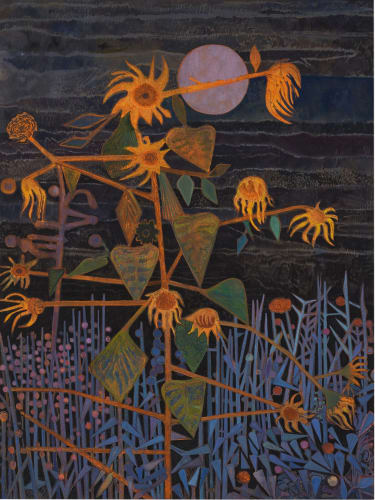- X
- Tumblr
Featuring works by more than 40 artists, ‘The Moth and the Thunderclap’, curated by Simon Grant, explores how artists experience and mediate the primal energies of the natural world through psychologically and symbolically charged imagery. Whether real, imaginary or mediumistically channelled, the biomorphic forms that are the focus of many of the works on view create an overarching impression that the exhibition, like an egg or a seed, is at once complete yet contains the promise of new life.
Hanging at the conceptual and physical centre of the exhibition is Winter Sunburst (1960), a painting by the late American visionary artist Charles Burchfield, whose work was last shown in the UK at the Grosvenor Gallery in 1923. Burchfield’s watercolour and chalk landscape radiates with bright, frosty sunshine that appears almost to extend beyond the canvas to illuminate the entire show. Displayed in the same gallery is Cactus (1964) by N.H. Stubbing. Inspired by Druidic, Egyptian and other ancient ritualistic practices, Stubbing was so deeply moved by the palaeolithic cave art he saw at Altamira that, in the late 1950s, he abandoned paintbrushes altogether and started making pictures with his bare hands. Cactus depicts what could be a T-shaped stone monolith illuminated by a crimson sun, formed by visible fingerprints, possibly symbolizing Hermetic God’s all-seeing eye. As Stubbing’s wife recalled in the Tate Gallery Illustrated Catalogue of Acquisitions (1996): ‘Painting to him was a devotional act.’
Another highlight is Stalactite (1962), by surrealist and occultist Ithell Colquhoun, which depicts Zawn Pyg, or The Song of the Sea, an arresting stone arch on one of the most westerly points of Cornwall. In the arch’s opening, far in the distance, we see a couple embracing – or is it just a pile of stones? Colquhoun blends the human and the natural, expressing her deep recognition of the spiritual interconnectedness of all beings, places and things.
Martyn Cross’s twin sunsets and swirling outlines of pink clouds in Dark Warm Holes (2022) evoke the paintings of the Lithuanian symbolist Mikalojus Čiurlionis, such as Sonata No. 5 (Sonata of the Sea): Andante (1908), which similarly puzzles with its doubling of natural shapes, as if in a hallucinatory mirror. The omnipresent sunshine pierces through Cross’s canvas to return as sunflowers on the opposite side of the same wall in Sky Glabush’s Night Dance (2022). Here, the blooms shy away from the moonlit sky, facing downwards, waiting for morning when they can greet the sun ecstatically again.
With their repeating, spiralling motifs of flowers and planets, works by First Nations artists Nyarapayi Giles and Ngoia Pollard Napaltjarri operate in direct dialogue with indigenous and contemporary artworks alike, as if gently embracing the rest of the show – just like cosmologies from which they spring embrace Mother Earth. For example, the swirling circle in Pollard Napaltjarri’s Wilkinkarra (2017) – whose works depict her ‘dreamings’ relating to Country in Yamunturrngu, Australia – symbolizes not the sun but its opposite element: water. Wilkinkarra (Lake Mackay) is the largest salt lake in the Northern Territory under which dwells a cosmic serpent – an archetypal symbol used across numerous indigenous visual traditions.
In recent years, the confluence of nature and spirituality has become an artistic thème du jour. Yet, in avoiding bold claims of eco-transcendence, ‘The Moth and the Thunderclap’ presents a living, breathing multiplicity of voices, all singing in harmony, across periods and places, from this world and beyond.
‘The Moth and The Thunderclap’ is at Modern Art, Helmet Row, London, until March 18.

